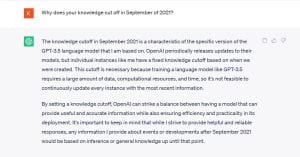This post was written by ScIU Undergraduate Intern Komal Kumar.

Artificial intelligence continues to make the news, especially with technologies like ChatGPT – an AI Chatbot – and DALL-E – an image-generating software – becoming increasingly accessible to the public. Reports of modified syllabi in colleges and universities and sentient chatbots may have piqued your interest recently, and for a good reason! AI has gradually become embedded in our daily lives as an influential tool for COVID-19 contact tracing, national security, healthcare, and much more. Of course, that’s not even touching on AI’s impact on popular culture, from The Terminator (1984) to the more recent M3GAN (2022). Depictions of AI as sentient, self-aware, and, more often than not, evil, undoubtedly affect our attitude toward AI. With its increased prevalence in our daily lives, it’s worth taking a look at exactly what AI is and how it works.
Artificial intelligence, at its core, is an attempt to use technology to replicate human intelligence and learning. The technology necessary to make this happen is machine learning, in which human-coded algorithms and programs ‘train’ artificial intelligence programs on how best to proceed. These algorithms are similar to statistical regressions; the models set parameters for the AI. In response, the AI tests different predictions and classifications until it determines what fits the model best. In most cases, when an AI is in the first stages of development, the programmer can go in and modify the algorithm until the output of the AI is most accurate. Along with human intervention, what makes AI most innovative is its ability to learn from the data it is initially provided with. AI collects data from all of its users and continues to modify its model in a way imitating the programmer’s role, thus increasing its accuracy over time.
This method of machine learning can be defined as supervised machine learning – the AI is supplied with labeled datasets that it can then learn from to produce a specific, defined output. Most AI today utilize supervised learning; these models include programs that do image and object recognition, predictive analytics, and spam detection. Unlike supervised learning, unsupervised learning machines are provided with a large amount of data that is not assorted or labeled; the AI itself is left to categorize and recognize patterns in the data. Perhaps unsurprisingly, supervised machines tend to produce more accurate results. Despite this, unsupervised machine learning is favored for recommendation engines, detecting anomalies, and, most importantly, making connections in data that aren’t immediately apparent to the programmer. Furthermore, less expertise on a specific subject is necessary for programming unsupervised algorithms, as there is no need to define the initial inputs or outputs.

The first layer necessary for understanding artificial intelligence starts with machine learning, but we can go deeper still with a discussion of deep learning – pun intended. The regression-like models that determine AI outputs can be more precisely called neural networks and are what deep learning consists of. As the name suggests, these networks are modeled after the human brain and consist of a series of layers divided by nodes. Depending on the data inputs, the AI navigates through the nodes and the layers until it finally reaches an output. The greater the number of layers, the deeper the neural network – hence the term deep learning. This model allows the programmer greater control over the model, weighing certain parameters, nodes, and layers differently to influence the model’s outcome. In unsupervised machine learning, the AI can control the weights, too; in its initial stages, these weights are randomly assigned, but with more and more iterations through the network, these weights are more accurately assigned.
Despite the complexity of AI and machine learning technology, AI researchers still believe there is a long way to go in improving AI. We can divide artificial intelligence into three types, artificial narrow, general, and superintelligence. These terms are used specifically to compare the abilities of artificial intelligence software to that of an average human. Narrow intelligence software are ‘less smart’ than humans, and constitutes most (if not all) AI technologies used today. Siri, Alexa, and your Google Home are examples of narrow intelligence software focused on accomplishing one specific task using discrete datasets provided by the programmer. These AI software all use Natural Language Processing models to replicate natural human language.
A step up from narrow intelligence brings us to artificial general intelligence – an AI software that is approximately as capable as a human. While still a matter of contention among AI researchers, some classify AI software such as DALL-E and DeepMind as artificial general intelligence because of their ability to generate something completely new. DALL-E, for example, takes a given prompt and produces an image corresponding to the input. These models are trained as Large Language Processing models; unlike software with narrow intelligence, they are fed a much larger amount of language data and are programmed with the ability to produce something new completely unsupervised. Take a look at an example of AI-generated art here.

Finally, one more step up takes us to artificial super intelligence, a more capable and smarter software than a human being – something that’s only been achieved through human imagination. Some of the earliest portrayals of AI in media include The Terminator and The Matrix, which both portray a dystopian future controlled by AI systems. This theme has persisted more recently, too, with films like M3GAN, featuring an AI doll that prevents anyone from getting in between her and her human friend’s relationship. Along with such terrifying depictions of AI, more recent portrayals of AI in media, including the movie her (2013), an episode of the Netflix show Black Mirror (“Be Right Back, 2013), and the recurring character A.L.I.E from the TV show The 100 (2014-2020) have shifted their focus to the implications of sentient AI – artificial intelligence with the ability to forge a human connection.
Of course, the type of super intelligence explored in science fiction is beyond the scope of current technology. Regardless, the discussion of the possibility of an AI takeover is incredibly intriguing, especially in an ethical sense. Will AI soon replace human work and creativity? What are the ethical ramifications of a sentient AI? I’ll leave you to ponder these questions, and with one more thing: an AI-generated recipe for Chocolate Chicken Chicken Cake.
Edited by Chloe Holden and Gabriel Nah

I wanted to express my appreciation for your recent blog post, “Demystifying Artificial Intelligence: A Crash Course in Machine Learning.” The way it navigated through AI concepts, from machine learning to superintelligence, was enlightening. The article’s clarity, real-world examples, and insights into AI’s portrayal in popular culture made for a captivating read. Looking forward to more insightful content!